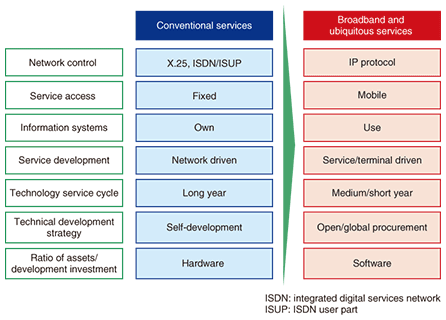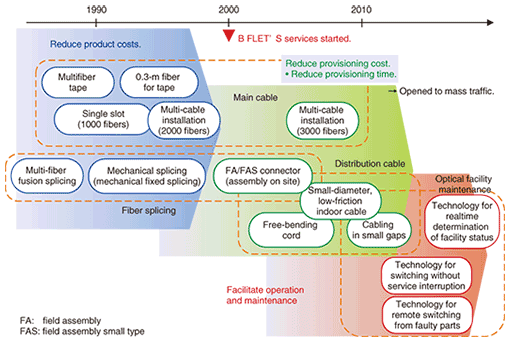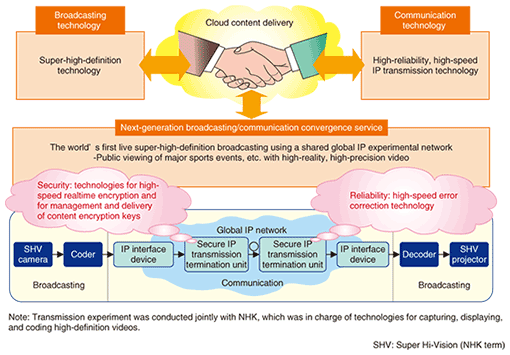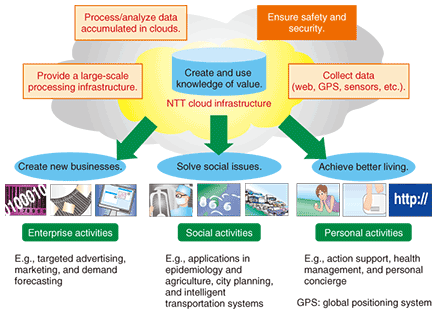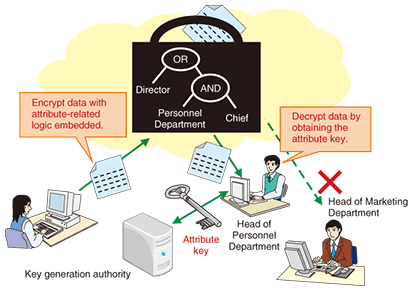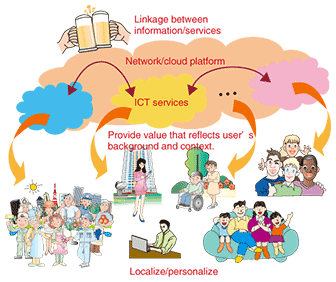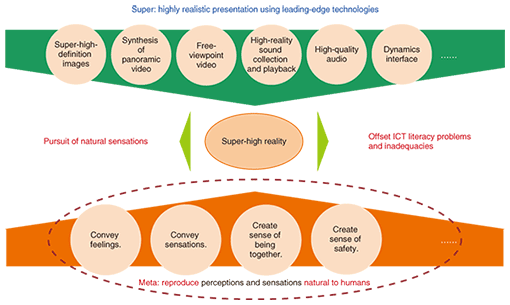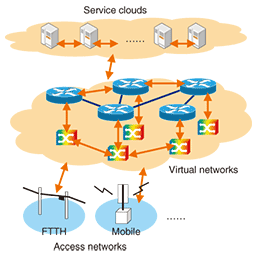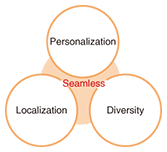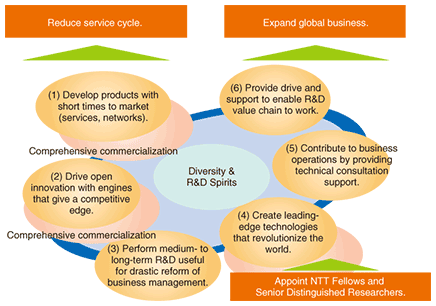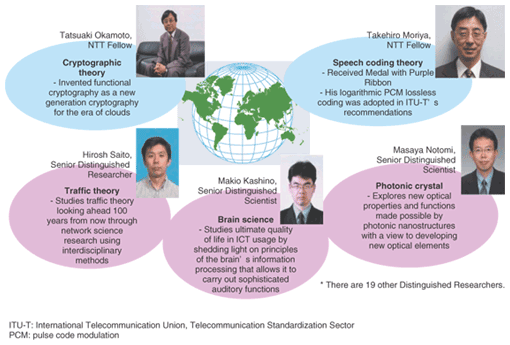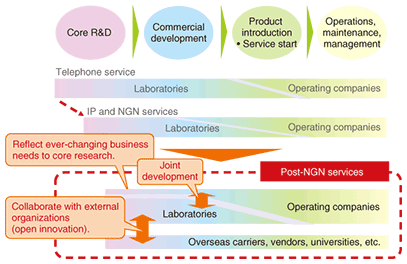 |
|
|
|
|
|
Feature Articles: Keynote Speeches at NTT R&D Forum 2011 Vol. 9, No. 4, pp. 12–22, Apr. 2011. https://doi.org/10.53829/ntr201104fa2 NTT’s Persistent Dedication to InnovationAbstractThis article introduces NTT’s research and development (R&D) activities aimed at maintaining and developing information and communications technology (ICT) services and pursuing further innovation as a carrier R&D organization. It is based on a lecture given by Hiromichi Shinohara, NTT Senior Vice President, Director of Research and Development Planning Department, at the NTT R&D Forum 2011 held on February 21–23, 2011. 1. Missions as a carrier R&D organization1.1 Changes in the surrounding environmentRecent changes in the environment surrounding telecommunication networks have been dramatic (Fig. 1). Internet protocol (IP) technologies have accelerated the integration of core networks. In the field of access networks, it has become important to create services that make the most of the convergence of fixed and mobile networks, which were previously regarded as being independent of each other. Part of the background to these changes is rising customer demand for seamless service environments and the increasing availability of customer terminals that are compatible with both fixed and mobile networks. Services and terminals have taken the place of networks as the drivers of information communication evolution. These changes are accelerating transitions in the technologies used for information and communications technology (ICT) services. The main thrust of the NTT Group’s investment in facilities and research and development (R&D) has been shifting away from hardware toward software. The mode of access to information systems, including the quickly spreading cloud systems, is rapidly changing from ownership to leasing. To be able to respond to these major changes, our R&D strategy must be both open and global in many respects.
1.2 Why NTT, as a carrier, should engage in R&DThese extensive changes in the ICT environment prompt us to consider again the question of why a carrier should engage in R&D. From the perspective of providing good services to customers continuously and economically, the basic missions of NTT’s R&D can be summarized as: (i) continuously developing services and networks, (ii) retaining the competitive edge of the NTT Group and enhancing the Group’s value, (iii) creating new businesses and industries, and (iv) proposing the Group’s visions of the future on the basis of anticipated technical trends. In the light of these basic missions and the latest changes in the ICT environment, the following seven types of activity explain why NTT, as a carrier, should indeed engage in R&D. The first type of activity is R&D undertaken to sustain the core ICT technologies, such as ones for network security, traffic, quality, reliability and electromagnetic compatibility (EMC). The second is R&D of civil systems and operations, maintenance, and testing technologies, which are aimed at maintaining the health of networks. We will continue to pursue these two types of R&D activity regardless of how the ICT environment evolves. Although it is generally higher-layer applications that are currently attracting most attention, activities to sustain the underlying infrastructures of ICT systems are as important as ever. For example, we are working on a technology for cleaning and renovating buried conduits that already accommodate existing cables without any negative effect on them while creating space in the conduits for the insertion of new cables. The third activity is the construction of networks that will support sustained development of services. In considering network architecture migration, it has become essential to develop systems that are consistent with the strategy for investment in services and facilities or identify and utilize appropriate products that are commercially available. In the same manner, we will maximize the benefits of this activity by either changing it drastically or reinforcing it, depending on how the environment evolves. For example, early R&D activities on optical access, spanning some 30 years and leading to the launch of the fiber-to-the-home (FTTH) service in 2000, were devoted to reducing the product costs; however, after that launch, they took another direction and began to focus on reducing the installation cost and time for optical fibers, which are more difficult to handle than copper cables (Fig. 2). Thanks to those activities, NTT has been able to provide FTTH to more than ten million customers to date. To continue to provide a stable service to this massive number of customers, it is timely to shift our efforts toward the facilitation of operations and maintenance. In a departure from the traditional emphasis on self-development, we developed the Next Generation Network (NGN) by incorporating both self-developed and off-the-shelf products. In this process, we, as a carrier R&D organization, succeeded in combining the convenience and economy of IP technology with the reliability and security that characterize the telephone service. In the field of network management, we have been working to reduce total operational costs by developing an element management system infrastructure, which fills the gaps between the different maintenance interfaces of off-the-shelf products.
The fourth activity is delivery of high-value services that capitalize on high network functionality. Today, some argue that networks only need to provide dumb pipes. However, we believe that we should be committed to developing functions and services that can be implemented or enhanced only by making the most of network functions. For example, it is thanks to the collaboration between the high-quality, realtime video transcoding technology of broadcasting centers and the guaranteed-bandwidth IP multicasting technology of the network that it has become possible to provide simultaneous IP retransmission of terrestrial digital broadcasting both economically and with quality equivalent to that of terrestrial broadcasting. We will intensify our efforts to develop services that actively make use of network functionality. The fifth activity is development of technologies to enable economical maintenance and enhancement of fast-growing software assets. In addition to the conventional approach of developing products that utilize our software assets, we will study ways to improve software usability. The sixth activity is expansion of the scope of carrier business, including the development of safe and secure cloud infrastructure technologies and cloud-based services, and the application of optical communication devices to equipment used in other industries, such as medical services. Finally, leading-edge R&D, such as device and materials research leading to breakthroughs in networking and systems, and communication science will bring about innovations in services. We will continue to pursue these types of basic research because they enable us to develop long-term business visions based on technological trends and provide the foundation for sustained development of our business. 2. Recent R&D activitiesSome specific examples of our latest R&D activities are described below. (1) Super-high-definition IP transmission By combining broadcasting technology with NTT’s high-speed, high-reliability IP transmission technology, we successfully implemented the world’s first live super-high-definition broadcasting on a shared global IP experimental network (Fig. 3). We will continue our efforts to enhance customer convenience through the integration of broadcasting and telecommunications functions.
(2) New web search-based services We are enhancing web search services to enable users to find the information they seek more conveniently, easily, and rapidly than ever. Our word-of-mouth summarization technology automatically generates a summary from multiple reviews of a certain product to enable users to obtain a general idea of the product’s reputation at a glance. The first service in Japan based on this technology has been undergoing field trials since January 2011. (3) 69-Tbit/s super-high-speed optical transmission As the volume of traffic flowing in networks continues to increase, R&D of high-speed, high-capacity transmission systems is gaining in importance. There are systems with a capacity of 1.6 Tbit/s currently in operation in NTT’s networks. In the near future, ones capable of handling 10 Tbit/s will become available for commercial use. In March 2010, NTT developed a prototype that achieved a world record speed of 69.1 Tbit/s. We will continue to anticipate future increases in traffic and develop high-speed transmission systems to accommodate the expected growth. (4)1-Gbit/s wireless: multi-user MIMO transmission Although a combination of wired, wireless, and power line communication (PLC) transmission links are frequently used in customer premises networks, we believe that wireless transmission provides the greatest flexibility to users and will become the favored technology in due course. Wireless transmission is unlikely to achieve the same speed as optical transmission because the frequency availability is limited. Nevertheless, in August 2010, NTT demonstrated wireless transmission at 1.62 Gbit/s for the first time in the world, using beamforming of radio waves. This allows multiple terminals to share the same frequency. (5) Photonic crystal The crystal of an ordinary material has a periodic structure with a lattice spacing equivalent to the wavelength of an electron (about 0.1 nm). Since such a material allows electrons to pass through it, it can exhibit a variety of properties. A photonic crystal, on the other hand, which is fabricated manually and has a periodic structure with a spacing equivalent to the wavelength of light (about 100 nm), is known to interact intensely with light, resulting in the exhibition of novel physical properties, such as optical insulation, slow light, and negative refractive index. These properties are expected to lead to the development of optical devices that are highly compact and functional and consume extremely low amounts of energy. NTT has produced the world’s most cutting-edge photonic crystals, such as a super-high-speed optical switch that consumes only 420 aJ, which is the lowest energy consumption achieved anywhere in the world, and a laser that can carry information with the world’s lowest energy consumption of 8.8 fJ/bit (aJ: attojoule (10-18 J) and fJ: femtojoule (10-15 J)). (6) Five-senses interface Recent communication science activity has revealed that people compensate for missing information, even in the tactile sense, just as they do in the visual and auditory senses. We believe that it is important to explore basic knowledge about the transmission of information as recognized by all five senses if we are to achieve more natural sensations in communication, as will be described later. (7) Green R&D In November 2010, the NTT Group announced its environmental vision, THE GREEN VISION 2020. It calls for NTT’s R&D to make a significant contribution to the reduction of CO2 emissions by both the Group (Green of ICT) and society in general (Green by ICT) in order to achieve a low-carbon society. We are taking a multifaceted approach to meeting this expectation. One activity for reducing total power consumption by combining leading-edge technologies is an energy management system for datacenters (DEMS). It mobilizes power generation/feeding technology, coordinated server/air conditioner control technology, and virtual server control technology to reduce the power consumed by datacenters, for which demand is certain to increase. At the systems level, we are working to reduce the power consumed by passive optical network (PON) systems, which are widely used to provide the FTTH service. The power supply for optical network units (ONUs) is usually left on all the time; however, by suspending the power feed, except for the power required to sustain minimum functions, while the user is not communicating, we can reduce the power consumed by the access networks, which account for a large proportion of the power consumed by telecommunication networks because they are connected to a huge number of terminals. At the device level, we are developing nanomechanical logic circuits. When a cyclic voltage is applied to microscopic plate springs (thickness: 1.4 μm) to cause microscopic vibrations (about 10 nm), the springs can perform multiple AND and OR operations simultaneously. When this technology matures and a nanocomputer is eventually developed, its power consumption will be only 1% of that of current computers. In addition to these activities, we have been seeking to make the work processes of our researchers more energy efficient. At the R&D Forum held a year ago, we announced our goal of increased ICT-based remote conferencing and teleworking. The track records since April 2010 show that we have more or less attained the teleconferencing goal but achieved only about 60% of the teleworking goal. In order to fully attain these goals, we will improve operational procedures and develop necessary ICT tools. 3. Next steps for service creation3.1 Safe and secure cloudsAlthough Japan leads the world in the construction of an environment for broadband services, such as FTTH, it lags behind in the exploitation of ICT services. We should address social issues to encourage the use of such services. We believe that safe and secure cloud systems will be required as the underlying technology to resolve these issues. NTT’s cloud infrastructure R&D activities can be broadly classified into three areas: (i) provision of a large-scale processing infrastructure, (ii) collection of data, and (iii) processing and analysis of data accumulated in clouds. By making the most of knowledge generated in clouds, we will help improve the sophistication of enterprise activities, enhance the activities of individuals, and resolve social issues. For clouds to be widely accepted and used, they need to be safe and secure. We are working on technologies to ensure security and simple operation within clouds, in addition to ensuring safe and secure communications by making clouds interwork with relevant network functions (Fig. 4).
Data trace management technology prevents data falsification and unauthorized access to data by monitoring data movements within a cloud and data access. Although encryption and decryption have conventionally been associated through a one-to-one relationship, intelligent encryption technology has succeeded in expanding this relationship to one-to-many by using attribute-related logic (Fig. 5). This technology enables both security and flexible access control by encrypting data in clouds.
3.2 New forms of value provisionTo promote widespread use of ICT services, R&D should reinforce innovation-oriented activities in addition to addressing social issues. Although a variety of ICT services have become available, enabling users to participate more extensively in the cyber world, the information available on the Internet still appears as a huge and complex mixture of wheat and chaff to everyone except advanced users. The pursuit of economy and efficiency in Internet business activities has driven service providers to globalize, standardize, and consolidate services, resulting in a situation whereby the services market is controlled by a limited number of players. Although these changes in ICT services have brought many benefits to users, the services tend to target average users and to provide information selected on the basis of statistically derived average user behavior. They do not necessarily suit the needs and preferences of all types of users. We believe that ICT services should take account of each user’s background and context and provide value that is localized, without sacrificing a global perspective, and personalized for individual users (Fig. 6).
3.3 New forms of expression in communicationsProgress in user interfaces for terminals, such as the development of touch panels, has led to widespread use of smartphones and tablet terminals, lowering the barrier to the accessibility of ICT services for general users. However, the progress made to date in forms of expression in communications, such as high-definition video and three-dimensional video, has been targeted mainly at a small number of advanced users. Insufficient attention has been paid to improving the ease of use for general users and for physically challenged persons. NTT’s R&D will take two approaches in moving toward the ultimate goal of providing communications with a high sense of reality. The first is aimed at achieving super-high reality by using leading-edge technologies. This has been our primary focus thus far. We will continue activities in this area, such as development of super-high-definition video and free-viewpoint video. However, considering that the amount of information that people actually obtain through their five senses is somewhat limited, what people actually find realistic is not necessarily equal to how realistically information is presented. In this sense, it will be important to pursue a new approach of meta-reality whereby information is presented in ways that allow people to feel realistic sensations. Such ways will be based on cognitive science, which focuses on understanding the five senses and emotions. We believe that, by combining these super- and meta-realities, we can provide natural sensations and new forms of expression in communications that will compensate for parts missed by people with physical handicaps or inadequate ICT literacy (Fig. 7).
3.4 Seamless networkNetwork services now provide users with many options from a variety of aspects, such as speed and bandwidth, quality, and reliability. To enable users to make the most of these broad options according to their needs, it is important to make the communications environment seamless and provide services rapidly and economically. Specifically, we should enhance serviceability, economy, and cost elasticity by integrating clouds and virtual networks rather than constructing and operating separate networks for individual services and individual network hierarchies, as has been the case, so that customers can access the necessary network functions and resources only when they need them (Fig. 8).
3.5 Directions of innovationLet us consider how the overall directions of R&D change with the needs of the times. During the period when broadband environment construction was our primary concern, we pursued efficiency, convenience, and economy following global standards. Now, as we seek to enable a broad spectrum of customers, from elderly persons to children, to fully benefit from ICT services, we must shift the center of gravity of R&D toward enhancement of personalization, localization, and diversity in services and networks in addition to pursuing the previous objectives (Fig. 9).
4. Activities for further development4.1 Aspirations of NTT’s R&DIn order to achieve further innovation, our researchers must renew their commitment to upholding the three aspirations that have been fostered in our R&D activities over the years and embrace new approaches: (i) Master: Study technology with confidence while assessing its future impacts on business and society. (ii) Act responsibly: Develop ICT services with a strong sense of responsibility for fostering their use and accessibility throughout Japan. (iii) Raise each other’s abilities: Create new value through teamwork and interaction. 4.2 Accelerating and strengthening research on leading-edge technologiesAnother aspect of NTT’s R&D strength is its diversity. There are some 3000 researchers working in a variety of technological fields at various stages of technical development. Last year, to enable the whole R&D organization to benefit from this diversity and produce specific results, we defined six roles to ensure the dynamism of our R&D activities (Fig. 10).
As part of these efforts, we newly appointed one Senior Distinguished Researcher and two Senior Distinguished Scientists in addition to the two existing NTT Fellows in order to relieve excellent researchers of managerial responsibilities and clearly define their roles as leading the world in cutting-edge research (Fig. 11). Through these efforts, we hope to build an organizational system that will ensure that NTT continues to be a frontrunner in basic research.
4.3 Increasing pace and efficiency of R&DNTT has selected its R&D projects on the basis of its own understanding of what is likely to be needed. However, given the rapid changes currently taking place in our communications environment, there are more and more cases where NTT’s R&D, which is somewhat distant from its actual business operations, cannot adequately respond to the ever-changing needs of the operating companies. Last year, we began implementing specific solutions to this problem. For example, we introduced a mechanism whereby the needs of NTT’s business operations are reflected in the R&D stage for core technologies, and we have encouraged NTT Laboratories to develop systems in collaboration with operating companies from the early stages of R&D projects. We will continue to strengthen these approaches by various means, including collaborations with external players (Fig. 12).
4.4 R&D for global business expansionIn the sphere of global activities, we have promoted collaboration with major foreign carriers for standardization and joint activities with overseas researchers, mainly in the field of basic research. Recently, we have been reinforcing our ability to achieve global expansion of the use of the latest, world-leading technologies and services introduced by NTT, such as the NGN, FTTH, and IPTV (Internet protocol television). We are also working with partners that are not telecommunication carriers. For example, when a mine in Chile collapsed last year, Micomo, a local NTT-affiliated venture company that provides ICT services for mine operators, contributed to the rescue of the trapped miners by providing optical fibers and wireless technologies. We intend to raise the importance of achieving synergy between NTT Laboratories and NTT Group companies overseas, such as Dimension Data, and other companies in which NTT has a stake. We will review the targets and directions of our R&D and create new value to address the NTT Group’s global business needs. We will pursue early establishment of a mechanism to accelerate R&D by exploring and adopting promising technologies from around the world, instead of stressing self-development. 5. ConclusionNTT will focus its R&D activities in three directions: (i) undertaking R&D on a wide range of technologies, (ii) creating innovations from a carrier’s perspective, and (iii) strengthening the organizational system in order to expand global activities. We aim to continuously create new value as one of the world’s ICT innovation centers through open collaboration with partners both at home and abroad (Fig. 13).
|
|








